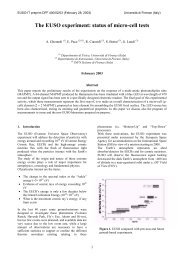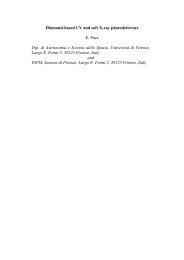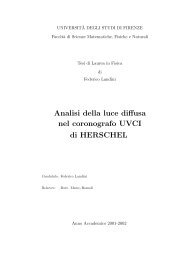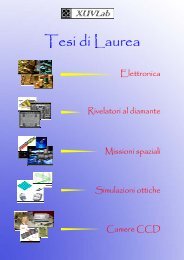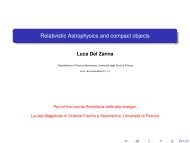2003 - Astronomia - Università degli Studi di Firenze
2003 - Astronomia - Università degli Studi di Firenze
2003 - Astronomia - Università degli Studi di Firenze
Create successful ePaper yourself
Turn your PDF publications into a flip-book with our unique Google optimized e-Paper software.
HERSCHEL<br />
The Helium Resonant Scattering in the Corona and Heliosphere (HERSCHEL) program is a<br />
collaboration among NASA and Naval Research Laboratory (NRL) in the USA; University of <strong>Firenze</strong>,<br />
Padova, Pavia and the Astronomical Observatory of Torino (OATo) in Italy; University of Paris in France.<br />
The principal investigators are Dr. Daniel Moses and Prof. Ester Antonucci.<br />
HERSCHEL has been selected within the Living With a Star (LWS) NASA program; the launch is scheduled for<br />
the autumn of 2006.<br />
Helium, the second largest contributor to the density of coronal plasma, is important for the dynamics of<br />
the solar wind, and it may act as a regulator to maintain a nearly constant solar wind mass flux. Despite this<br />
crucial role, there is a lack of observations of Helium in the corona.<br />
The HERSCHEL program will investigate the slow and fast solar wind, determine the helium <strong>di</strong>stribution and<br />
abundance in the corona, and test solar wind acceleration models, by obtaining simultaneous<br />
observations of the electron, proton and helium solar coronae.<br />
HERSCHEL is a sub-orbital mission, composed of a telescope similar to SOHO/EIT [1] and two UVC-like<br />
coronagraphs (UVCI, Ultraviolet and Visible-light Coronal Imager); the figure on page 06 shows the<br />
instrument layout inside the soun<strong>di</strong>ng rocket skin.<br />
The italian consortium is responsible for the UVCI coronagraphs. The UVCIs image the solar corona from<br />
1.4 Ro to 4Ro. One coronagraph is optimized to image the Lyman a HI 121.6 nm corona and one for the<br />
Lyman a HeII 30.4 nm corona. They both have a visible light channel, to measure coronal ra<strong>di</strong>ation linear<br />
polarization. A remarkable characteristic of the coronagraph is the presence of an electro-optically<br />
driven liquid crystals (LC) polarizer [2] within the polarimeter, an absolutely innovative feature for a space<br />
mission.The most stringent requirement on a coronagraph is the stray light rejection, and the novelty of the<br />
UVCI all-reflecting optical design, which is the first UV coronagraph to image the full corona at once, has<br />
made necessary a thorough stray light characterization of the coronagraph.<br />
To maintain the optical quality of the instrument, a deep tolerance analysis is needed, in order to<br />
determine the desired precision for the optical components mechanical positioning.<br />
The XUVLab is responsible for the stray light analysis, for the tolerance analysis and for the procurement of<br />
the visible-light CCD detectors, included the electronics needed to interface the detectors with the<br />
electro-optically driven LC polarizer.<br />
A theoretical study of light <strong>di</strong>ffraction from the coronagraph aperture and of the non-specular scattering<br />
off mirror surfaces has been carried out; a simulation algorithm has been developed using both the C<br />
programming language and the Interactive Data Language (IDL). The obtained results show that the stray<br />
light level is lower than the expected coronal signal at every wavelength of interest.<br />
Through a complex geometrical analysis on the reciprocal influence of the optical components<br />
positions, a table of angular and spatial tolerances of every optical component has been compiled.<br />
The resulting document has been given to the Carlo Gavazzi Space company to support the<br />
arrangement of the optical bench and the mechanical mounting of the instruments.<br />
References:<br />
1. J. Delabou<strong>di</strong>nière et al., EIT: Extreme-ultraviolet Imaging Telescope for the SOHO mission, Sol.<br />
Phys.<br />
162, 291-312, 1995<br />
2. L. Zangrilli, Polarimetria <strong>di</strong> lamine a cristalli liqui<strong>di</strong> a ritardo variabile, Master in applied optics thesis, University of Padova, <strong>2003</strong><br />
XUVLab activity summary <strong>2003</strong><br />
03<br />
space projects



